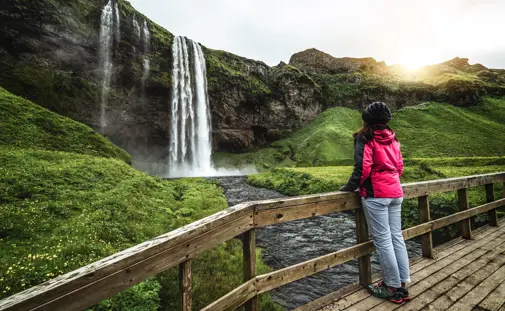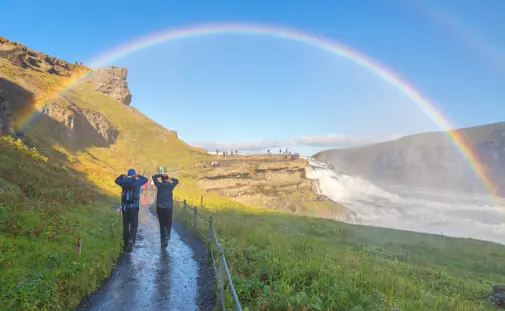Ásbyrgi is a remarkable horseshoe-shaped canyon located in the northern part of Iceland, within Vatnajökull National Park. Measuring about 3.5 kilometres (2.2 miles) in length and over 1 kilometre (0.6 miles) in width, Ásbyrgi is surrounded by towering cliffs that rise up to 100 metres (328 feet) high, creating a natural amphitheater of breathtaking beauty. The canyon is filled with lush vegetation, including birch trees and a variety of shrubs and wildflowers, making it a striking contrast to the more barren landscapes typical of Iceland.
According to Icelandic folklore, Ásbyrgi was formed when the hoof of Sleipnir, the eight-legged horse of the Norse god Odin, touched the ground, leaving this massive imprint. In reality, Ásbyrgi was likely created by catastrophic glacial flooding from the nearby Jökulsá á Fjöllum river thousands of years ago. At the center of the canyon stands a distinctive rock formation called Eyjan, or "The Island," which offers panoramic views of the surrounding landscape when climbed.
Ásbyrgi is a popular destination for hikers, nature lovers, and those interested in Icelandic mythology. Several well-marked trails lead through the canyon, offering opportunities to explore its unique geological features and rich flora.
Ásbyrgi Canyon Facts
-
Location: Vatnajökull National Park, North Iceland
-
Size: Approximately 3.5 km (2.2 miles) long and 1.1 km (0.7 miles) wide
-
Cliff Height: Up to 100 meters (328 feet) high
-
Main Features: Botnstjörn Pond and Eyjan (“The Island”) plateau
-
Formation: Created by two massive glacial floods around 10,000 and 3,000 years ago
-
Vegetation: Dense forest with birch, willow, pine, and rare wildflowers
-
Mythology: Formed by Sleipnir’s hoof, Óðins eight legged horse.
Formation & Geology
Ásbyrgi’s formation is a geological marvel shaped by powerful glacial floods known as “jökulhlaups.” Originating from the Vatnajökull glacier, these catastrophic floods occurred around 8,000-10,000 years ago, with a second flood roughly 3,000 years later, carving Ásbyrgi’s unique horseshoe shape. The canyon’s cliffs are composed of basaltic rock, a reminder of Iceland’s volcanic past, with the 100-meter-high cliffs enclosing dense vegetation that thrives due to natural protection from harsh northern weather. Adding to its geological uniqueness, the prominent Eyjan plateau rises within the canyon, offering panoramic views over the surrounding terrain.
Ásbyrgi Canyon Mythology
Ásbyrgi’s striking shape has given rise to various local legends. According to Norse mythology, Ásbyrgi is said to be the hoofprint of Sleipnir, Odin’s mythical eight-legged horse. As the tale goes, Odin rode Sleipnir over Iceland, and as the horse touched down, it left an impression that became Ásbyrgi. Another myth suggests that Ásbyrgi is home to Icelandic “hidden people,” or elves, who live undisturbed in the canyon’s verdant setting. The connection between Icelandic folklore and Ásbyrgi adds a mystical allure to this beautiful landscape.
What to Do in Ásbyrgi?
Ásbyrgi offers a variety of activities for visitors, including birdwatching, nature photography and it's one of Iceland's great hiking destinations. The Botnstjörn Pond at the canyon’s end is a popular spot where visitors can enjoy the tranquility of the area, surrounded by towering cliffs and lush vegetation. Hiking trails vary from easy walks through the forested area to more challenging treks, including the Eyjan plateau trail and Klappir, which provide spectacular views of the canyon. Birdwatchers can spot several species, particularly in summer when migratory birds visit the area.
-
Botnstjörn Hike: 1 km (0.6 miles), approximately 30min - 1 hour. Difficulty is considered easy and starts from the innermost car park near the pond.
-
Eyjan Plateau: 4,5 km (2.8 miles), approximately 1,5 - 2 hours. The trail is considered easy and starts from the north of the camping area. The trail reaches a stone cairn on top of the plateau which marks the turn point.
-
Klappir Hike: 9 km (5.6 miles), approximately 3 hours. Hike is considered challenging and starts at Gljúfrastofa the visitor center and Klappir marks the turning point.
-
Ásbyrgi to Dettifoss Trail: 32 km (20 miles), approximately 2 days. A challenging hike that starts at Gljúfrastofa visitor center and should only be taken by experienced hikers.
There are more hiking paths available and information can be found at the Ásbyrgi visitor center, the starting point for most of the longer hikes.
Ásbyrgi Campsite
The Ásbyrgi Campsite, located within Vatnajökull National Park, is a popular choice for travelers who wish to stay within the canyon’s beauty. It offers basic amenities, including toilets, showers, cooking facilities, and an information center nearby. The campsite is well-maintained and suitable for tents, campervans, and small RVs. Staying at the campsite provides a unique opportunity to explore the magnificent surroundings of Ásbyrgi at your own pace. You can visit Vatnajökul's website to book a spot.
Nearby Accommodations
For those seeking a bit more comfort, nearby towns offer various accommodations, from guesthouses to hotels:
-
Fosshótel Húsavík: Located in Húsavík, this hotel is a 45-minute drive from Ásbyrgi and offers modern rooms with convenient access to northern Iceland attractions.
-
Guesthouse Lyngholt: A cozy option in nearby Þórshöfn, this guesthouse provides simple but comfortable accommodations with easy access to the national park.
-
Nordic Natura: Near Mývatn, this eco-friendly lodge offers a peaceful retreat with sustainable accommodations and panoramic views of the surrounding landscapes.
Nearby Attractions
Located in North Iceland, Ásbyrgi is surrounded by captivating sites that make it an ideal base for further exploration. Nearby, Hljóðaklettar, or “Echo Rocks,” showcases a stunning array of basalt formations, uniquely shaped by natural erosion, creating striking rock structures that seem almost sculpted by hand. Another remarkable attraction is Dettifoss, Europe’s most powerful waterfall, where the roaring cascade within Vatnajökull National Park offers a dramatic and unforgettable experience. Just a short drive away lies Húsavík, Iceland’s renowned “whale-watching capital,” where visitors can enjoy guided tours to spot these majestic creatures and stroll through the charming harbor town. For those seeking relaxation, the Mývatn Nature Baths, affectionately known as the “Blue Lagoon of the North,” offer soothing geothermal waters set against the scenic beauty of the Mývatn region, blending relaxation with breathtaking views.
These destinations located around Ásbyrgi Canyon are worth exploring, especially if you’ve decided to camp at Ásbyrgi or stay in the area.
Ásbyrgi Location
Ásbyrgi Canyon is located in the northeastern part of Vatnajökull National Park, approximately 60 kilometers (37 miles) east of Húsavík. This area, known for its rugged beauty and remote landscapes, is part of the Diamond Circle, a popular tourist route in North Iceland that includes some of the region’s most iconic sites.
- GPS Coordinates: 66°01'43.3"N 16°29'13.2"W
How to Get to Ásbyrgi Canyon
Getting to Ásbyrgi from different parts of Iceland is straightforward, especially in summer when roads are easily accessible. From Húsavík, Ásbyrgi is a 45-minute drive along Route 85. If traveling from Akureyri, follow Route 1 east to the turnoff onto Route 85, with a drive of approximately 1.5 hours. From Reykjavík, Ásbyrgi is roughly 6,5 hours away by car, traveling northeast via Route 1 and Route 85.
Parking and Facilities
Ásbyrgi has designated parking areas near the visitor center and campsite, providing easy access to trails and main attractions within the canyon. The visitor center offers information about the area, trail maps, and safety tips for hikers. Facilities are basic but include toilets, picnic areas, and an information kiosk.
Visitors can also drive further along the gravel road, past the visitor center and campsite and into the canyon. At the end of the road guests can park close to Botnstjörn Pond and enjoy strolling around the canyon’s forest.
Ásbyrgi in Winter
Ásbyrgi’s beauty is undeniable in winter, with snow-covered cliffs and a hushed landscape that feels magical. While the roads may be more challenging due to icy conditions, Ásbyrgi remains accessible in winter. A common question from visitors is whether you can see the Northern Lights from Ásbyrgi; luckily the answer is yes. Ásbyrgi’s remote location and limited light pollution make it a great spot for viewing the aurora borealis. Winter visitors are advised to check road conditions and dress warmly.



